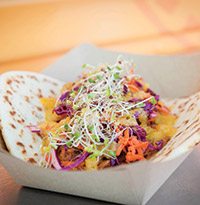Bye-bye fine dining. Today’s customers are forgoing the frills and frequenting food trucks, fast-casual favourites and charming restaurants for savoury snacks, comfort food and easy-to-nosh burgers, sandwiches, wraps and smoothies.
One key trend that’s taking centre stage is fast-casual dining, heralded for offering premium ingredients at affordable prices. “Consumers are starting to see [that] they can get really good food for a low price, so they are trading up from fast food,” explains Kelly Weikel, senior consumer research manager at Chicago’s Technomic research firm. At Mississauga, Ont.’s Mucho Burrito, customers can pick up flour or whole-wheat burritos filled with premium ingredients such as pan-seared tilapia (small, $7.19). Meanwhile, fast-casual burger chains, such as U.S. import Five Guys Burgers and Fries, offers made-to-order patties dressed with premium toppings, such as its hamburger with grilled onions, mushrooms and green peppers ($6.99).
Snacks are also taking the spotlight, since 56 per cent of customers snack multiple times a day, according to Technomic’s “Canadian Snacking Consumer Trend Report.” When customers have less time for a sit-down meal, wraps fill the need for a quick bite. One such example is McDonald’s new Chicken and Bacon Signature McWrap, which is filled with lettuce, tomatoes and jalapeño monterey jack cheese ($4.99 each). What’s more, the definition of a snack is now broader than ever, and it’s blurring the line between different dayparts. “It’s going towards more beverages, and we’re seeing consumers are considering drinks, especially coffee, tea and smoothies a good snack and [going to] restaurants more for that as well,” says Weikel. For example, at Panera Bread, customers can grab a fat-free superfruit power smoothie, with Greek yogurt and ginseng (prices vary by location).
“[Casual food] comes and goes with the ebb and flow of economics,” says Anthony Rose, who serves comfort food with a twist at his Toronto-based Rose and Sons restaurant. “Ten years ago there was a ton of fine-dining establishments in [Toronto]; now, most of them have gone by the wayside.” In a downturn, customers choose casual eateries that don’t hurt the budget, and that trend has continued into better economic times. Rose’s concept plays on nostalgia, but it offers more upscale food, such as fried rice with egg, pork belly, ginger, peanuts and china-town sauce ($14) or the patty melt burger, with grilled cheese, fried onions, french fries and chili mayo ($16).
Meanwhile, food trucks are more than just a vehicle for the casual-food movement; the meals-on-wheels provide the perfect opportunity for chefs to showcase creative renditions of street-food classics. For example, Calgary’s Naaco Truck offers tacos with an Indian twist, such as its Paunchy Pig Naaco on naan bread, filled with pork, Indian five-spice, seasonal vegetable salad with a roasted poblano dressing, tamarind and pineapple chutney as well as green onions ($10), with spiced green iced-tea ($3). “It’s all the flavours of a traditional Indian buffet, in one mobile, handheld platform,” describes AmanAdatia, co-owner. Consumers stuck inside the “comfort-food zone” can also grab a mom-and-pop-style mac-and-cheese from Vancouver’s Reel Mac and Cheese, which offers a rendition of the classic, topped with fried egg and caramelized onions ($9). And, the handheld treats are also becoming a staple at premium-casual chains such as Vancouver’s Cactus Club Café, which offers Ocean Wise lingcod fish tacos on hand-stretched tortillas ($14). Weikel sums it up: “[Operators] have to have something a bit different that makes them stand out, that creates a signature that will help drive consumer craving and sales.”
Keep Reading



















